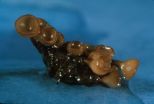Outcomes of communication about end-of-life care appear to differ between black and white patients
2010-09-28
(Press-News.org) While both black patients and white patients appear to benefit from end of life discussions with their physician, black patients are less likely to experience end-of-life care that accurately reflects their preferences, according to a report in the September 27 issue of Archives of Internal Medicine, one of the JAMA/Archives journals.
"Although black patients are also more likely than white patients to desire life-prolonging measures, receipt of life-prolonging care at the end of life is associated with greater distress and with poorer quality of life," the authors write as background to the study. "These findings raise the concern that black patients receive inferior end-of-life care, a possibility underscored by disparities between black patients and white patients in certain objective care measures, such as pain management."
Jennifer W. Mack, M.D., M.P.H., of the Dana-Farber Cancer Institute, Boston, and colleagues studied 332 patients who were recruited between October 2002 and September 2007, were self-identified as non-Hispanic white or black, had cancer with distant metastases with failure of first-line chemotherapy, were 20 years of age or older and died during the course of the study.
The authors found that black patients reported similar rates of end-of-life discussions to white patients, but were less aware that their illness was terminal. Compared with white patients who had not had end-of-life discussions with their healthcare clinician, those that had end-of-life discussions tended to have a shorter survival time from baseline assessment. Additionally, the authors found that compared with black patients with fewer years of education, black patients with more education were marginally more likely to report having end-of-life discussions with their physician.
"Despite similar rates of end-of-life discussions, white patients were more likely than black patients to prefer symptom-directed care over life-prolonging end-of-life care and to have DNR [do not resuscitate] orders in place. White patients were also less likely to receive life-prolonging care in their last week of life." The authors also found that, "although end-of-life discussions and communication goals assist white patients in receiving less burdensome life-prolonging care at the end-of-life, black patients tend to receive more aggressive care regardless of their preferences." Additionally, black patients without DNR orders are just as likely to receive life-prolonging treatment as black patients with a DNR.
Based on the findings, the authors conclude that, "although the reasons for our findings are not fully understood, white patients appear to have undefined advantages when it comes to receiving end-of-life care that reflects their values."
###
(Arch Intern Med. 2010;170[17]:1533-1540. Available pre-embargo to the media at www.jamamedia.org.)
Editor's Note: This study was supported by a grant from the National Institute of Mental Health, a grant from the National Cancer Institute, by a Fetzer Religion at the End-of-Life Grant and by the Center for Psycho-oncology and Palliative Care Research, Dana-Farber Cancer Institute. Please see the article for additional information, including other authors, author contributions and affiliations, financial disclosures, funding and support, etc.
END
ELSE PRESS RELEASES FROM THIS DATE:
2010-09-28
Home-based exercises followed by voluntary home training seem to be associated with long-term effects on balance and gait (manner of walking), and may help protect high-risk, elderly women from hip fractures, according to a report in the September 27 issue of Archives of Internal Medicine, one of the JAMA/Archives journals.
"Falls are responsible for at least 90 percent of all hip fractures," the authors write as background in the article. "Hip fractures place the greatest demands on resources and have the greatest effect on patients because they are associated with high ...
2010-09-28
Use of pine bark extract, at a dose of 200 milligrams per day, appears safe but did not improve risk factors for heart disease, according to a report in the September 27 issue of Archives of Internal Medicine, one of the JAMA/Archives journals.
"Although traditional strategies such as prescription medications, dietary changes and physical activity have proven benefits for reducing cardiovascular disease risk, a substantial population seeks alternative therapies, including various dietary supplements, to lower cardiovascular disease risk," the authors write as background ...
2010-09-28
ANN ARBOR, Mich.---The more complex a plant or animal, the more difficulty it should have adapting to changes in the environment. That's been a maxim of evolutionary theory since biologist Ronald Fisher put forth the idea in 1930.
But if that tenet is true, how do you explain all the well-adapted, complex organisms---from orchids to bower birds to humans---in this world?
This "cost of complexity" conundrum puzzles biologists and offers ammunition to proponents of intelligent design, who hold that such intricacy could arise only through the efforts of a divine designer, ...
2010-09-28
Software downloaded during a routine office visit cuts the risk of inappropriate shocks by 50 percent for patients with implantable cardioverter defibrillators (ICD), according to research reported in Circulation: Journal of the American Heart Association.
"Hundreds of patients have been saved from unnecessary shocks by software that is safe and can be painlessly downloaded in one minute during a standard defibrillator check," said Charles D. Swerdlow, M.D., lead author of the study and a cardiac electrophysiologist at the Cedars Sinai Heart Institute in Los Angeles and ...
2010-09-28
Using data from more than 270,000 hospital stroke admissions, scientists have identified how to predict which patients are at greatest risk of dying in the hospital after stroke. Before their study, well validated models to predict in-hospital death risk after stroke were lacking, the researchers reported in Circulation: Journal of the American Heart Association.
"A mortality risk assessment tool for hospitalized stroke patients is important to clinicians, hospitals and patients," said Eric E. Smith, M.D., M.P.H., lead author of the study and assistant professor of neurology ...
2010-09-28
VIDEO:
In a few tenths of a second, Sclerotinia expels hundreds of thousands of spores in a plume that can rise 20 cm, much higher than any single spore by itself....
Click here for more information.
Long before geese started flying in chevron formation or cyclists learned the value of drafting, fungi discovered an aerodynamic way to reduce drag on their spores so as to spread them as high and as far as possible.
One fungus, the destructive Sclerotinia sclerotiorum, ...
2010-09-28
In a paper published this week in the Proceedings of the National Academy of Sciences, Cary Institute aquatic ecologist Dr. Emma Rosi-Marshall and colleagues report that streams throughout the Midwestern Corn Belt are receiving insecticidal proteins that originate from adjacent genetically modified crops. The protein enters streams through runoff and when corn leaves, stalks, and plant parts are washed into stream channels.
Genetically-modified plants are a mainstay of large-scale agriculture in the American Midwest, where corn is a dominant crop. In 2009, more than ...
2010-09-28
Burness Communications
Godwin Atser
g.atser@cgiar.org
234-803-443-0027
CGIAR
Scientists arrive in Senegal to give African hunger a black eye
At the World Cowpea Research Conference, crop experts embrace one of agriculture's oldest legumes -- prized for protein and resilience to hot, dry climates -- as food for people, livestock and astronauts
This release is available in French.
DAKAR, SENEGAL (27 September 2010)—A long neglected crop with the potential to halt hunger for millions in Africa, sustain the livestock revolution underway in developing countries, ...
2010-09-28
Researchers in the Midwest are developing microelectronic circuitry to guide the growth of axons in a brain damaged by an exploding bomb, car crash or stroke. The goal is to rewire the brain connectivity and bypass the region damaged by trauma, in order to restore normal behavior and movement.
Pedram Mohseni, a professor of electrical engineering and computer science at Case Western Reserve University, and Randolph J. Nudo, a professor of molecular and integrative physiology at Kansas University Medical Center, believe repeated communications between distant neurons in ...
2010-09-28
Baby boomers appear to be driving a dramatic rise in suicide rates among middle-aged people, a new study finds.
The suicide rate for middle-aged people – a group considered relatively protected from suicide and with historically stable suicide rates – took an upward jump between 1999 and 2005, according to research by sociologists Ellen Idler of Emory University and Julie Phillips of Rutgers University.
Their study has been published in the September/October issue of the journal Public Health Reports.
"The findings are disturbing, because they're a reversal of a long-standing ...
LAST 30 PRESS RELEASES:
[Press-News.org] Outcomes of communication about end-of-life care appear to differ between black and white patients

